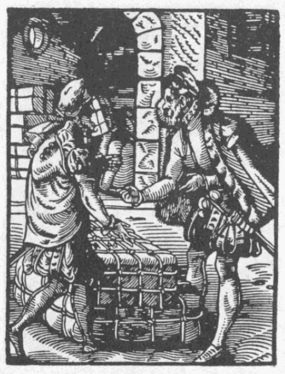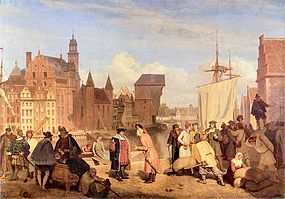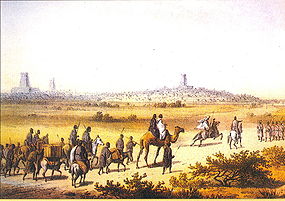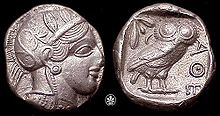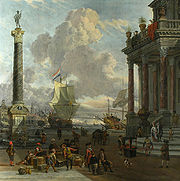- Trade
-
Purchase redirects here. For other uses, see Purchase (disambiguation)
Trade is the transfer of ownership of goods and services from one person or entity to another. Trade is sometimes loosely called commerce or financial transaction or barter. A network that allows trade is called a market. The original form of trade was barter, the direct exchange of goods and services. Later one side of the barter were the metals, precious metals (poles, coins), bill, paper money. Modern traders instead generally negotiate through a medium of exchange, such as money. As a result, buying can be separated from selling, or earning. The invention of money (and later credit, paper money and non-physical money) greatly simplified and promoted trade. Trade between two traders is called bilateral trade, while trade between more than two traders is called multilateral trade.
Trade exists for man due to specialization and division of labor, most people concentrate on a small aspect of production, trading for other products. Trade exists between regions because different regions have a comparative advantage in the production of some tradable commodity, or because different regions' size allows for the benefits of mass production. As such, trade at market prices between locations benefits both locations.
Retail trade consists of the sale of goods or merchandise from a very fixed location, such as a department store, boutique or kiosk, or by mail, in small or individual lots for direct consumption by the purchaser.[1] Wholesale trade is defined as the sale of goods or merchandise to retailers, to industrial, commercial, institutional, or other professional business users, or to other wholesalers and related subordinated services.[2]
Trading can also refer to the action performed by traders and other market agents in the financial markets.
Contents
History of trade
Part of a series on Trade routes Amber Road · Hærvejen . Incense Route Kamboja-Dvaravati Route . King's Highway . Northern Arc Roman-India routes . Royal Road Silk Road · Spice Route . Tea route Varangians to the Greeks · Via Maris Triangular trade .Volga trade route Trans-Saharan trade . Salt Route Hanseatic League . Grand Trunk Road Prehistory
Trade originated with the start of communication in prehistoric times. Trading was the main facility of prehistoric people, who bartered goods and services from each other before the innovation of the modern day currency. Peter Watson dates the history of long-distance commerce from circa 150,000 years ago.[3]
Ancient History
Trade is believed to have taken place throughout much of recorded human history. There is evidence of the exchange of obsidian and flint during the stone age. Materials used for creating jewelry were traded with Egypt since 3000 BC. Long-range trade routes first appeared in the 3rd millennium BC, when Sumerians in Mesopotamia traded with the Harappan civilization of the Indus Valley. The Phoenicians were noted sea traders, traveling across the Mediterranean Sea, and as far north as Britain for sources of tin to manufacture bronze. For this purpose they established trade colonies the Greeks called emporia. From the beginning of Greek civilization until the fall of the Roman empire in the 5th century, a financially lucrative trade brought valuable spice to Europe from the far east, including India and China. Roman commerce allowed its empire to flourish and endure. The Roman empire produced a stable and secure transportation network that enabled the shipment of trade goods without fear of significant piracy.
The fall of the Roman empire, and the succeeding Dark Ages brought instability to Western Europe and a near collapse of the trade network in the western world. Trade however continued to flourish among the kingdoms of Africa, Middle East, India, China and Southeast Asia. Some trade did occur in the west. For instance, Radhanites were a medieval guild or group (the precise meaning of the word is lost to history) of Jewish merchants who traded between the Christians in Europe and the Muslims of the Near East.
Middle Ages
During the Middle Ages, Central Asia was the economic center of the world.[4] The Sogdians dominated the East-West trade route known as the Silk Road after the 4th century AD up to the 8th century AD, with Suyab and Talas ranking among their main centers in the north. They were the main caravan merchants of Central Asia.
From the 8th to the 11th century, the Vikings and Varangians traded as they sailed from and to Scandinavia. Vikings sailed to Western Europe, while Varangians to Russia. The Hanseatic League was an alliance of trading cities that maintained a trade monopoly over most of Northern Europe and the Baltic, between the 13th and 17th centuries.
Age of Discovery
Vasco da Gama pioneered the European Spice trade in 1498 when he reached Calicut after sailing around the Cape of Good Hope at the southern tip of the African continent. Prior to this, the flow of spice into Europe from India was controlled by Islamic powers, especially Egypt. The spice trade was of major economic importance and helped spur the Age of Discovery in Europe. Spices brought to Europe from the Eastern world were some of the most valuable commodities for their weight, sometimes rivaling gold.
In the 16th century, the Seventeen Provinces were the centre of free trade, imposing no exchange controls, and advocating the free movement of goods. Trade in the East Indies was dominated by Portugal in the 16th century, Holland in the 17th century, and the British in the 18th century. The Spanish Empire developed regular trade links across both the Atlantic and the Pacific Oceans.
In 1776, Adam Smith published the paper An Inquiry into the Nature and Causes of the Wealth of Nations. It criticised Mercantilism, and argued that economic specialisation could benefit nations just as much as firms. Since the division of labour was restricted by the size of the market, he said that countries having access to larger markets would be able to divide labour more efficiently and thereby become more productive. Smith said that he considered all rationalisations of import and export controls "dupery", which hurt the trading nation as a whole for the benefit of specific industries.
In 1799, the Dutch East India Company, formerly the world's largest company, became bankrupt, partly due to the rise of competitive free trade.
Age of Reason
In 1817, David Ricardo, James Mill and Robert Torrens showed that free trade would benefit the industrially weak as well as the strong, in the famous theory of comparative advantage. In Principles of Political Economy and Taxation Ricardo advanced the doctrine still considered the most counterintuitive in economics:
- When an inefficient producer sends the merchandise it produces best to a country able to produce it more efficiently, both countries benefit.
The ascendancy of free trade was primarily based on national advantage in the mid 19th century. That is, the calculation made was whether it was in any particular country's self-interest to open its borders to imports.
John Stuart Mill proved that a country with monopoly pricing power on the international market could manipulate the terms of trade through maintaining tariffs, and that the response to this might be reciprocity in trade policy. Ricardo and others had suggested this earlier. This was taken as evidence against the universal doctrine of free trade, as it was believed that more of the economic surplus of trade would accrue to a country following reciprocal, rather than completely free, trade policies. This was followed within a few years by the infant industry scenario developed by Mill promoting the theory that government had the "duty" to protect young industries, although only for a time necessary for them to develop full capacity. This became the policy in many countries attempting to industrialise and out-compete English exporters. Milton Friedman later continued this vein of thought, showing that in a few circumstances tariffs might be beneficial to the host country; but never for the world at large.[5]
20th Century
The Great Depression was a major economic recession that ran from 1929 to the late 1930s. During this period, there was a great drop in trade and other economic indicators.
The lack of free trade was considered by many as a principal cause of the depression. Only during the World War II the recession ended in the United States. Also during the war, in 1944, 44 countries signed the Bretton Woods Agreement, intended to prevent national trade barriers, to avoid depressions. It set up rules and institutions to regulate the international political economy: the International Monetary Fund and the International Bank for Reconstruction and Development (later divided into the World Bank and Bank for International Settlements). These organisations became operational in 1946 after enough countries ratified the agreement. In 1947, 23 countries agreed to the General Agreement on Tariffs and Trade to promote free trade.
Free Trade
Free trade advanced further in the late 20th century and early 2000s:
- 1992 European Union lifted barriers to internal trade in goods and labour.
- January 1, 1994 the North American Free Trade Agreement (NAFTA) took effect
- 1994 The GATT Marrakech Agreement specified formation of the WTO.
- January 1, 1995 World Trade Organization was created to facilitate free trade, by mandating mutual most favoured nation trading status between all signatories.
- EC was transformed into the European Union, which accomplished the Economic and Monnetary Union (EMU) in 2002, through introducing the Euro, and creating this way a real single market between 13 member states as of January 1, 2007.
- 2005, the Central American Free Trade Agreement was signed; It includes the United States and the Dominican Republic.
Protectionism
Protectionism is the policy of restraining and discouraging trade between states and contrasts with the policy of free trade. This policy often takes of form of tariffs and restricitive quotas. Protectionist policies were perticularly prevelent in the 1930s, between the great depression and the onset of World War II.
Religion
Muslim teachings encourage trading (and condemn usury).[6][7]
Judeo-Christian teachings encourage traders to avoid dishonest gain.[citation needed]
Development of money
The first instances of money were objects with intrinsic value. This is called commodity money and includes any commonly available commodity that has intrinsic value; historical examples include pigs, rare seashells, whale's teeth, and (often) cattle. In medieval Iraq, bread was used as an early form of money. In Mexico under Montezuma[disambiguation needed
 ] cocoa beans were money. [1]
] cocoa beans were money. [1]Currency was introduced as a standardised money to facilitate a wider exchange of goods and services. This first stage of currency, where metals were used to represent stored value, and symbols to represent commodities, formed the basis of trade in the Fertile Crescent for over 1500 years.
Numismatists have examples of coins from the earliest large-scale societies, although these were initially unmarked lumps of precious metal.[8]
Ancient Sparta minted coins from iron to discourage its citizens from engaging in foreign trade.
Current trends
Doha rounds
Main article: Doha roundThe Doha round of World Trade Organization negotiations aims to lower barriers to trade around the world, with a focus on making trade fairer for developing countries. Talks have been hung over a divide between the rich developed countries, represented by the G20, and the major developing countries. Agricultural subsidies are the most significant issue upon which agreement has been hardest to negotiate. By contrast, there was much agreement on trade facilitation and capacity building.
The Doha round began in Doha, Qatar, and negotiations have subsequently continued in: Cancún, Mexico; Geneva, Switzerland; and Paris, France and Hong Kong.
China
Beginning around 1978, the government of the People's Republic of China (PRC) began an experiment in economic reform. In contrast to the previous Soviet-style centrally planned economy, the new measures progressively relaxed restrictions on farming, agricultural distribution and, several years later, urban enterprises and labor. The more market-oriented approach reduced inefficiencies and stimulated private investment, particularly by farmers, that led to increased productivity and output. One feature was the establishment of four (later five) Special Economic Zones located along the South-east coast.
The reforms proved spectacularly successful in terms of increased output, variety, quality, price and demand. In real terms, the economy doubled in size between 1978 and 1986, doubled again by 1994, and again by 2003. On a real per capita basis, doubling from the 1978 base took place in 1987, 1996 and 2006. By 2008, the economy was 16.7 times the size it was in 1978, and 12.1 times its previous per capita levels. International trade progressed even more rapidly, doubling on average every 4.5 years. Total two-way trade in January 1998 exceeded that for all of 1978; in the first quarter of 2009, trade exceeded the full-year 1998 level. In 2008, China's two-way trade totaled US$2.56 trillion.
In 1991 the PRC joined the Asia-Pacific Economic Cooperation group, a trade-promotion forum. In 2001, it also joined the World Trade Organization. See also: Economy of the People's Republic of China
International trade
Trade barriers
Tariffs · Non-tariff barriers
Import quotas · Tariff-rate quotas
Quota share · Import licenses
Customs duties · Export subsidies
Technical barriers · Bribery
Exchange rate controls · Embargo
Safeguards
Countervailing duties
Anti-dumping duties
Voluntary export restraintsOrganizationsBy CountryInternational trade is the exchange of goods and services across national borders. In most countries, it represents a significant part of GDP. While international trade has been present throughout much of history (see Silk Road, Amber Road), its economic, social, and political importance have increased in recent centuries, mainly because of Industrialization, advanced transportation, globalization, multinational corporations, and outsourcing. In fact, it is probably the increasing prevalence of international trade that is usually meant by the term "globalization".
Empirical evidence for the success of trade can be seen in the contrast between countries such as South Korea, which adopted a policy of export-oriented industrialization, and India, which historically had a more closed policy (although it has begun to open its economy, as of 2005). South Korea has done much better by economic criteria than India over the past fifty years, though its success also has to do with effective state institutions.
Trade sanctions
Trade sanctions against a specific country are sometimes imposed, in order to punish that country for some action. An embargo, a severe form of externally imposed isolation, is a blockade of all trade by one country on another. For example, the United States has had an embargo against Cuba for over 40 years.
Trade barriers
Although there are usually few trade restrictions within countries, international trade is usually regulated by governmental quotas and restrictions, and often taxed by tariffs. Tariffs are usually on imports, but sometimes countries may impose export tariffs or subsidies. All of these are called trade barriers. If a government removes all trade barriers, a condition of free trade exists. A government that implements a protectionist policy establishes trade barriers.
Fair trade
The fair trade movement, also known as the trade justice movement, promotes the use of labour, environmental and social standards for the production of commodities, particularly those exported from the Third and Second Worlds to the First World. Such ideas have also sparked a debate on whether trade itself should be codified as a human right.[9]
Importing firms voluntarily adhere to fair trade standards or governments may enforce them through a combination of employment and commercial law. Proposed and practiced fair trade policies vary widely, ranging from the common prohibition of goods made using slave labour to minimum price support schemes such as those for coffee in the 1980s. Non-governmental organizations also play a role in promoting fair trade standards by serving as independent monitors of compliance with fair trade labeling requirements.
Notes
- ^ "Distribution Services". Foreign Agricultural Service. 2000-02-09. http://www.fas.usda.gov/info/factsheets/China/distribution.html. Retrieved 2006-04-04.
- ^ WTO – World Trade Organization
- ^ Watson (2005), Introduction.
- ^ Beckwith (2011), p. xxiv.
- ^ Price theory Milton Friedman
- ^ Nomani & Rahnema (1994), p. ?. "I want nine out of ten people from my Ummah (nation) as traders" and "Trader, who did trading in truth, and sold the right quantity and quality of goods, he will stand along Prophets and Martyrs, on Judgment day".
- ^ "O ye who believe! Eat not up your property among yourselves in vanities; but let there be among you traffic and trade by mutual good-will." Quran 4:29 and "Allah has allowed trading and forbidden usury." Quran 2:275
- ^ Gold was an especially common form of early money, as described in Davies (2002).
- ^ "Should trade be considered a human right?". COPLA. 9 December 2008. http://www.cop-la.net/en/node/523.
Bibliography
- Beckwith, Christopher I (2011) [2009]. Empires of the Silk Road: A History of Central Eurasia from the Bronze Age to the Present. Princeton: University Press. ISBN 978-0-691-15034-5.
- Bernstein, William (2008). A Splendid Exchange: How Trade Shaped the World (2009 British ed.). London: Atlantic Books. ISBN 971-1-84354-803-4.
- Davies, Glyn (2002) [1995]. Ideas: A History of Money from Ancient Times to the Present Day. Cardiff: University of Wales Press. ISBN 978-0-708-31773-0. http://www.ex.ac.uk/~RDavies/arian/origins.html.
- Nomani, Farhad; Rahnema, Ali (1994). Islamic Economic Systems. New Jersey: Zed Books. ISBN 1-85649-058-0.
- Watson, Peter (2005). Ideas: A History of Thought and Invention from Fire to Freud. New York: HarperCollins Publishers. ISBN 978-0-06621-064-3.
Categories:- International trade
- Trade routes
- Trade
Wikimedia Foundation. 2010.

